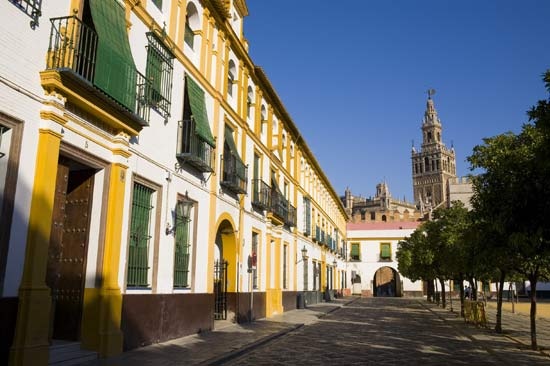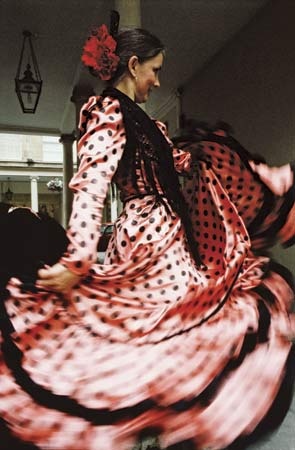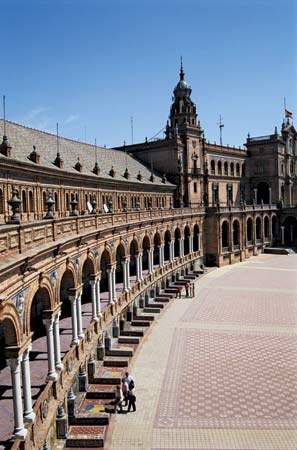Sevilla
Colombia
city, Cauca departamento, western Colombia, on an abutment of the Cordillera Central. Founded as San Luis in 1903 by Heraclio Uribe Uribe, the city was renamed for Sevilla, Spain, when it became a municipality in 1914. Gold, silver, and platinum mines are nearby, and agricultural products (beef, coffee, sugar, tobacco, cacao, bananas, cassava, and cereals) are marketed. Pop. (2007 est.) 34,414.
Spain
conventional Seville, ancient Hispalis
 city, capital of the provincia (province) of Sevilla, in the Andalusia comunidad autónoma (autonomous community) of southern Spain. Sevilla lies on the left (east) bank of the Guadalquivir River at a point about 54 miles (87 km) north of the Atlantic and about 340 miles (550 km) southwest of Madrid. An inland port, it is the chief city of Andalusia and the fourth largest in Spain. Sevilla was important in history as a cultural centre, as a capital of Muslim Spain, and as a centre for Spanish exploration of the New World.
city, capital of the provincia (province) of Sevilla, in the Andalusia comunidad autónoma (autonomous community) of southern Spain. Sevilla lies on the left (east) bank of the Guadalquivir River at a point about 54 miles (87 km) north of the Atlantic and about 340 miles (550 km) southwest of Madrid. An inland port, it is the chief city of Andalusia and the fourth largest in Spain. Sevilla was important in history as a cultural centre, as a capital of Muslim Spain, and as a centre for Spanish exploration of the New World.Sevilla was originally an Iberian town. Under the Romans it flourished from the 2nd century BC onward as Hispalis, and it was an administrative centre of the province of Baetica. The Silingi Vandals made it the seat of their kingdom early in the 5th century AD, but in 461 it passed under Visigothic rule. In 711 the town fell to the Muslims, and under their rule Ixvillia, as it was then called, flourished. It became a leading cultural and commercial centre under the ʿAbbādid dynasty and the subsequent Almoravid and Almohad confederations. As the Almohad capital in the 12th century, Sevilla enjoyed great prosperity and ambitious building programs. But after the Muslim possession of Sevilla was ended in 1248 by Spanish Christians under Ferdinand III, the substantial Moorish and Jewish minorities were driven into exile, and the local economy temporarily fell into ruin.
The Spanish discovery of the Americas brought new prosperity to the city. Sevilla became the centre of the exploration and exploitation of America through the Casa de Contratación (Contratación, Casa de) (“House of Trade”), which was established there in 1503 to regulate commerce between Spain and the New World. For two centuries Sevilla was to hold a dominant position in Spain's New World commerce; it was the site of the chief mint for gold and silver from the Americas, and many Spanish emigrants to the New World sailed from its quays. Sevilla was in fact the richest and most populous city in Spain in the 16th century, with some 150,000 inhabitants in 1588. This brilliance was fleeting, however, since Sevilla's prosperity was based almost entirely on the exploitation of the colonies rather than on local industry and trade. As a result, Sevilla's economy declined in the 17th century, though its cultural life underwent a great flowering at that time. The painters Diego Velázquez (Velázquez, Diego), Francisco de Zurbarán (Zurbarán, Francisco de), and Bartolomé Esteban Murillo (Murillo, Bartolomé Esteban), the sculptor Juan Martínez Montañés (Montañés, Juan Martínez), and the poet Fernando de Herrera (Herrera, Fernando de) are the glories of Sevilla and of Spain. Miguel de Cervantes (Cervantes, Miguel de) conceived of his novel Don Quixote while he was confined in Sevilla's jail.
In the 18th century Spain's Bourbon rulers managed to stimulate a limited economic revival in the city, but in the 19th century the French invasion, revolutions, and civil war halted such development. In 1847 the April Fair, an annual gala following Easter, was established. The Iberoamerican Exposition of 1929 initiated a new renaissance in Sevilla. During the 20th century the port was enlarged, and the city revived as an industrial and commercial centre. The Universal Exposition world's fair opened in Sevilla in 1992, spurring the construction of new monuments and modernization. New roads and a train station were built as well as the high-speed train, Alta Velocidad Española (AVE), which connects Sevilla to Madrid in less than three hours. The old train station, Antigua Estación de Córdoba, was restored and is now an exhibition hall. New bridges were also constructed, as well as a theatre, an auditorium, and the Congress Palace. Moreover, the Guadalquivir River, which had been diverted around the city for centuries, was brought back into its original riverbed.

 Sevilla's many architectural monuments survived the Spanish Civil War (1936–39) intact because the city was held by the Nationalists throughout the entire conflict and was thus never fought over. The oldest part of Sevilla lies on the left bank of the Guadalquivir and is irregularly planned, with a maze of narrow and twisting streets, small enclosed squares, and houses built and decorated in the Moorish style. There is a somewhat more spacious layout in the central district near the Cathedral of Santa Maria and the Alcázar Palace. Sevilla's cathedral is one of the largest in area of all Gothic churches. Most of it was constructed from 1402 to 1506 on the site of the city's principal mosque, which had been built by the Almohads in 1180–1200 on the site of an earlier Visigothic church. One of the mosque's few surviving portions, its minaret, called the Giralda, was incorporated into the cathedral as its bell tower. The minaret has surfaces almost entirely covered with beautiful yellow brick and stone paneling of Moorish design. The main portion of the Cathedral of Santa Maria is built in the Late Gothic style of France, but its various parts display building styles ranging from the Moorish through the Gothic to the Plateresque and the Baroque. The cathedral's interior contains paintings by Murillo and Zurbarán, among others.
Sevilla's many architectural monuments survived the Spanish Civil War (1936–39) intact because the city was held by the Nationalists throughout the entire conflict and was thus never fought over. The oldest part of Sevilla lies on the left bank of the Guadalquivir and is irregularly planned, with a maze of narrow and twisting streets, small enclosed squares, and houses built and decorated in the Moorish style. There is a somewhat more spacious layout in the central district near the Cathedral of Santa Maria and the Alcázar Palace. Sevilla's cathedral is one of the largest in area of all Gothic churches. Most of it was constructed from 1402 to 1506 on the site of the city's principal mosque, which had been built by the Almohads in 1180–1200 on the site of an earlier Visigothic church. One of the mosque's few surviving portions, its minaret, called the Giralda, was incorporated into the cathedral as its bell tower. The minaret has surfaces almost entirely covered with beautiful yellow brick and stone paneling of Moorish design. The main portion of the Cathedral of Santa Maria is built in the Late Gothic style of France, but its various parts display building styles ranging from the Moorish through the Gothic to the Plateresque and the Baroque. The cathedral's interior contains paintings by Murillo and Zurbarán, among others.The finest survival from the Moorish period is the Alcázar Palace, which lies near the cathedral. The Alcázar was begun in 1181 under the Almohads but was continued under the Christians; like the cathedral, it exhibits both Moorish and Gothic stylistic features. A decagonal brick tower, the Torre del Oro, once part of the Alcázar's outer fortifications, remains a striking feature of the riverbank. Other examples of Moorish building are the tower of the Church of San Marcos (once the minaret of a mosque) and two sides of the cathedral's Patio de Naranjos. Sevilla has many other churches built in the Gothic, Renaissance, Baroque, and Rococo styles.
The Casa Lonja, adjacent to the cathedral and finished in 1599, houses the General Archive of the Indies, a superb collection of books, plans, manuscripts, and several million documents bearing on the history and administration of Spain's empire in the Americas. The University of Sevilla, founded in 1502, is now housed in the imposing Baroque and Rococo buildings of the old Tobacco Factory, which was completed in 1757. The city museum has a fine collection of paintings of the Sevilla school, with works by Velázquez, Zurbarán, Murillo, and Juan Valdés Leal. Sevilla is still the seat of a Roman Catholic bishopric.
More spacious and regular planning is found beyond the walls of the old city centre, where there are residential and industrial districts. Maria Luisa Park is a particularly beautiful park in the southern part of the city. Five miles (8 km) northwest of Sevilla are the ruins of the large Roman town of Itálica, which was the birthplace of the emperors Trajan and Hadrian. The remains of its amphitheatre are especially imposing.
Modern Sevilla is the most important inland port of Spain. The port's principal exports are wines, fruit, olives, cork, and minerals; its imports include oil, coal, and metallurgical products, which serve the Guadalquivir valley and other areas of Andalusia. The city's industries include the manufacture of tobacco, armaments, porcelain, aircraft parts, chemical products, and agricultural machinery. Shipbuilding became a major industry after World War II, as did the manufacture of textiles from locally grown cotton. Commerce, services, and tourism are other economic mainstays of the city.
 Sevilla is known for its celebrations and festivals. One of the most famous of these occurs during Semana Santa, or Holy Week, the seven days leading up to Easter. The festival features colourful processions of floats depicting religious scenes carried by cofradías (brotherhoods) from their churches to the Cathedral of Santa Maria. The city's April Fair, first held in the mid-19th century, celebrates the Andalusian countryside. Sevilla hosts the Biennial of Flamenco Art, and flamenco performances are prevalent in the city's many tablaos (bars). Other neighbourhood and religious festivals are held throughout the year. There is a bullring in the city. Pop. (2006 est.) 694,071.
Sevilla is known for its celebrations and festivals. One of the most famous of these occurs during Semana Santa, or Holy Week, the seven days leading up to Easter. The festival features colourful processions of floats depicting religious scenes carried by cofradías (brotherhoods) from their churches to the Cathedral of Santa Maria. The city's April Fair, first held in the mid-19th century, celebrates the Andalusian countryside. Sevilla hosts the Biennial of Flamenco Art, and flamenco performances are prevalent in the city's many tablaos (bars). Other neighbourhood and religious festivals are held throughout the year. There is a bullring in the city. Pop. (2006 est.) 694,071.province, Spain
conventional Seville
 provincia (province) in the comunidad autónoma (autonomous community) of Andalusia, southwestern Spain. The province comprises the lower Guadalquivir River valley and has varied relief. It is bordered by the Morena Mountains to the northwest and by the Sub-Baetic ranges of the Algodonales and Caballo mountains to the south and southeast. Between these ranges is the low, undulating surface (campiñas) of the Guadalquivir (Guadalquivir River) trough.
provincia (province) in the comunidad autónoma (autonomous community) of Andalusia, southwestern Spain. The province comprises the lower Guadalquivir River valley and has varied relief. It is bordered by the Morena Mountains to the northwest and by the Sub-Baetic ranges of the Algodonales and Caballo mountains to the south and southeast. Between these ranges is the low, undulating surface (campiñas) of the Guadalquivir (Guadalquivir River) trough.Below Sevilla city, the provincial capital, the navigable Guadalquivir River forms the marshy plains of Las Marismas before entering the Atlantic Ocean. These plains are the haunt of wildfowl; bulls are pastured there, and land-reclamation projects have long been in progress. Most of the land is contained in Coto Doñana National Park.
On the fertile campiñas, olives, wheat, rice, cotton, sugar beets, and oranges are cultivated on large estates. The raising of sheep and goats is also a significant component of the local economy. The agricultural population along the northern course of the Guadalquivir is scattered among numerous small towns, many on ancient Roman sites, around which horticulture is practiced on small holdings, all somewhat isolated from main routes of communication. Together with its agricultural wealth, the province yields copper, iron ore, and coal. Food processing and the production of automotive parts, metals, and textiles are considerable sources of income. The service industry (especially tourism) has grown in importance. The main population centres, apart from Sevilla, are Écija, Carmona, Marchena, Utrera, Morón de la Frontera, and Osuna. Area 5,419 square miles (14,036 square km). Pop. (2007 est.) 1,849,268.
- South Yorkshire
- Soutine, Chaim
- Souvanna Phouma
- Sovereign Council
- Sovereigns of Britain
- Sovereigns of Scotland
- sovereignty
- Sovetsk
- Sovetskaya Gavan
- Commune of Paris
- communication
- communion of saints
- communism
- Communist Manifesto, The
- Communist Party of Cuba
- Communist Party of Spain
- Communist Party of the Russian Federation
- Communist Party of the Soviet Union
- community
- community ecology
- Community of Christ
- community property
- commutation
- commutative law
- Commynes, Philippe de